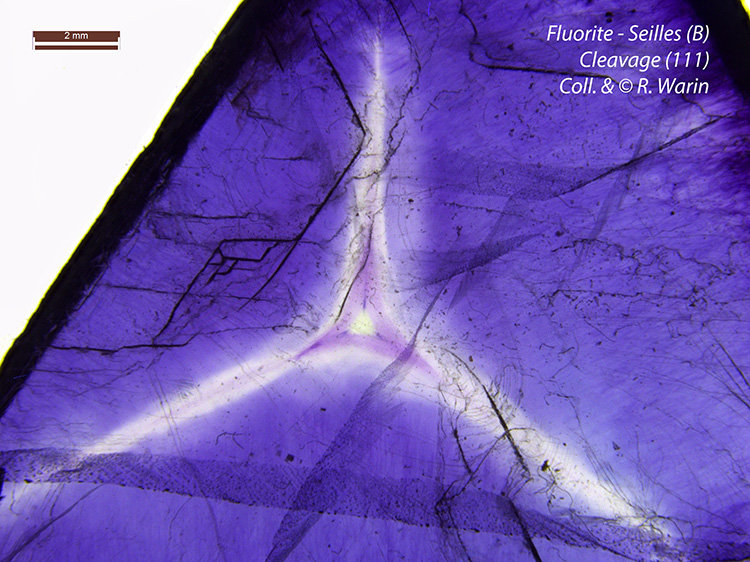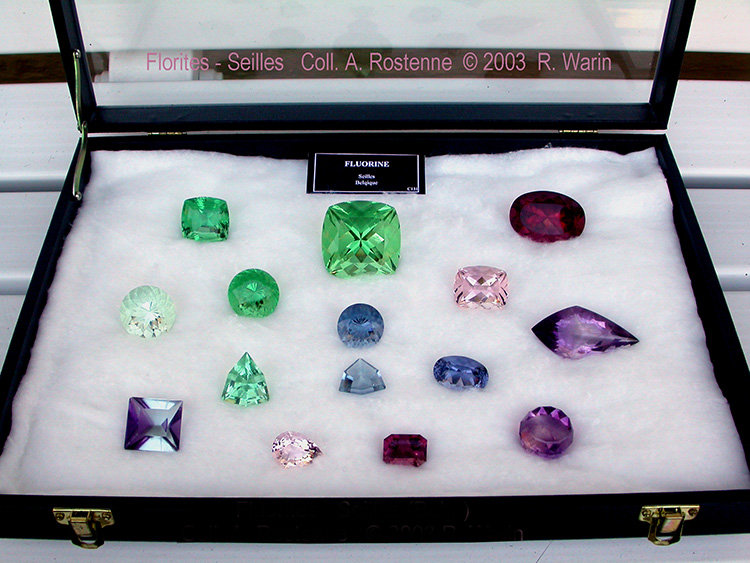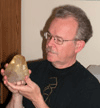| View previous topic :: View next topic |
| Author |
Message |
Roger Warin

Joined: 23 Jan 2013
Posts: 1243



|
 Posted: Nov 28, 2023 09:37 Post subject: Fluorite Star Posted: Nov 28, 2023 09:37 Post subject: Fluorite Star |
|
|
Fluorite – Mercedes-Benz Star
Good tools allowed me to take a good photo of this Mercedes star included in a fluorite crystal from Seilles (Huy-Belgium).
The crystals of fluorite are sometimes large, up to 20 cm on a side.
However, the faces of octahedrons are very often corroded, by a dissolution process, I think.
Beautiful gems have been cut from this material and that of Dr André Rostenne † can be found at the National Museum of Natural Sciences in Luxembourg.
Many poorly formed specimens were cleaved by amateurs and André had given me a few cleavages.
These were made to highlight a star or triangular cross whose symmetry reveals the position of the ternary axis of the fluorite.
For a long time, I had hypothesized that this star highlighted the edges of the dodecahedron. But obviously without being able to prove it.
This fairly clear photo would perhaps provide proof of this hypothesis.
In fact, the branches of the star are triangular, which I had not observed before taking the photo.
My question to you, particularly Pete, are these triangles compatible with section (111) of the dodecahedron?
We can also notice that at the end of crystallization, the content of cations giving the color has reduced, to the point of allowing pure CaF2 to crystallize. Then the last little star appeared with a purple hue induced another additional impurity.
Hydrothermal waters are in motion and can become depleted and then supplied with CaF2 and other cations.
| Mineral: | Fluorite |
| Locality: | | Seilles, Andenne, Namur Province, Wallonia Region, Belgium |  |
|
| Description: |
|
| Viewed: |
9237 Time(s) |

|
| Mineral: | Fluorites |
| Locality: | | Seilles, Andenne, Namur Province, Wallonia Region, Belgium |  |
|
| Description: |
|
| Viewed: |
9263 Time(s) |

|
|
|
| Back to top |
|
 |
Bob Morgan
Joined: 18 Jan 2018
Posts: 251
Location: Savannah, Georgia



|
 Posted: Nov 28, 2023 13:08 Post subject: Re: Fluorite Star Posted: Nov 28, 2023 13:08 Post subject: Re: Fluorite Star |
|
|
| The purple shape appears to be hexoctahedral in nature, having three pairs of isosceles triangles centered around a triangular shape. You've definitely found the tri-fold axis of the cleaved octahedral face.
|
|
| Back to top |
|
 |
Bob Carnein
Joined: 22 Aug 2013
Posts: 355
Location: Florissant, CO



|
 Posted: Nov 28, 2023 13:12 Post subject: Re: Fluorite Star Posted: Nov 28, 2023 13:12 Post subject: Re: Fluorite Star |
|
|
| Roger, This doesn't answer your question, but I wondered whether this fluorite (like some of the purple fluorite from this locality) fluoresces red?
|
|
| Back to top |
|
 |
Pete Richards
Site Admin

Joined: 29 Dec 2008
Posts: 846
Location: Northeast Ohio



|
 Posted: Nov 28, 2023 20:06 Post subject: Re: Fluorite Star Posted: Nov 28, 2023 20:06 Post subject: Re: Fluorite Star |
|
|
| Roger Warin wrote: | Fluorite – Mercedes-Benz Star
(snip)
My question to you, particularly Pete, are these triangles compatible with section (111) of the dodecahedron? |
I must say I am not very comfortable trying to interpret color patterns in sections of crystals, especially when the actual shape of the crystal is unknown. I note that the images of fluorite specimens on Mindat from this locality do not seem to show any crystal morphology, which hinders an attempt to understand this color pattern.
I presume it is safe to assume that this is a slice perpendicular to a triad axis, especially given the cleavage of fluorite.
My guess about this pattern is that the white rays represent the boundaries of three growth sectors formed under three faces of the same form, or sectors under a narrow beveling face, which may amount to the same thing. Such a pattern could happen with sectors under three dodecahedral faces that meet at the triad axis, but it could also happen with three cube faces that meet at the triad axis. In the first case, the boundary between faces of the dodecahedron, if it had finite width, would correspond to a face of the trapezohedron {211}; in the second case it would correspond to a face of the dodecahedron ({110}. More than this I am reluctant to speculate.
It is important to realize that this slice is probably not synchronous. Given either of the morphologies proposed above, the edges of a (111) slice would be the most recent to form, and the area of the triad axis would be the oldest. Thus face-specific influences on color may be mingled with temporal changes in the chemistry that produced the various colors and perhaps change the crystal morphology.
I hope someone else can shed more light on this interesting question.
_________________
Collecting and studying crystals with interesting habits, twinning, and epitaxy |
|
| Back to top |
|
 |
|





